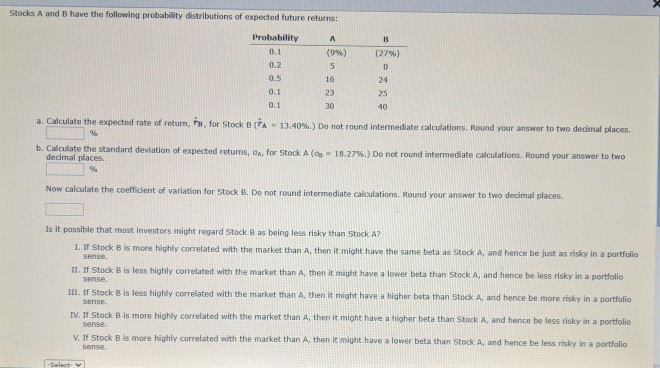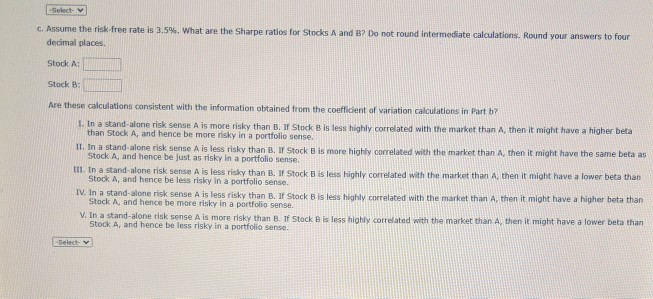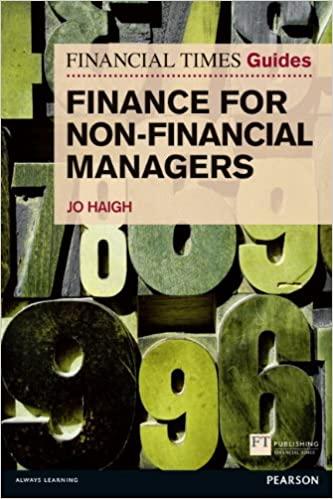Answered step by step
Verified Expert Solution
Question
1 Approved Answer
Stocks A and B have the following probability distributions of expected future returns: A B Probability 0.1 0.2 (9%) 5 0.5 (27%) 0 24 25


Stocks A and B have the following probability distributions of expected future returns: A B Probability 0.1 0.2 (9%) 5 0.5 (27%) 0 24 25 40 16 23 30 0.1 0.1 a. Calculate the expected rate of return, fa, for Stock B (PA - 13.40%.) Do not round intermediate calculations. Round your answer to two decimal places % b. Calculate the standard deviation of expected retums, c. for Stock A (-18.27%.) Do not round intermediate calculations. Round your answer to two decimal places 96 Now calculate the coefficient of variation for Stock B. Do not round intermediate calculations. Round your answer to two decimal places. Is it possible that most investors might regard Stock B as being less risky than Stock A? 1. If Stock B is more highly correlated with the market than A, then it might have the same beta as Stock A, and hence be just as risky in a portfolio sense. 11. If Stock B is less highly correlated with the market than A then it might have a lower beta than Stock A, and hence be less risky in a portfolio sense III. If Stock B is less highly correlated with the market than A then it might have a higher beta than Stock A, and hence be more risky in a portfolio Sense IV. If Stock B is more highly correlated with the market than A, then it mloht have a higher beta than Stock A, and hence be less risky in a portfolio sense V. If Stock B is more highly correlated with the market than A, then it might have a lower beta than Stock A, and hence be less risky in a portfolio sense. -Select -Select- C. Assume the risk free rate is 3.5%. What are the Sharpe ratios for Stocks A and B? Do not round intermediate calculations. Round your answers to four decimal places Stock A: Stock 8: Are these calculations consistent with the information obtained from the coefficient of variation calculations in Part b? I. In a stand-alone risk sense A is more risky than B. If Stock B is less highly correlated with the market than A, then it might have a higher beta than Stock A, and hence be more risky in a portfolio sense. II. In a stand-alone risk sense A is less risky than B. If Stock B is more highly correlated with the market than A, then it might have the same beta as Stock A, and hence be just as risky in a portfolio sense. III. In a stand-alone risk sense A is less risky than B. If Stock is less highly correlated with the market than A, then it might have a lower beta than Stock A, and hence be less risky in a portfolio sense IV. In a stand-alone risk sense A is less risky than B. If Stock Bis leis highly correlated with the market than A then it might have a higher beta than Stock A, and hence be more risky in a portfolio sense. V. In a stand-alone risk sense A is more risky than B. If Stock is less highly correlated with the market than A then it might have a lower beta than Stock A, and hence be less risky in a portfolio sense -Select
Step by Step Solution
There are 3 Steps involved in it
Step: 1

Get Instant Access to Expert-Tailored Solutions
See step-by-step solutions with expert insights and AI powered tools for academic success
Step: 2

Step: 3

Ace Your Homework with AI
Get the answers you need in no time with our AI-driven, step-by-step assistance
Get Started


